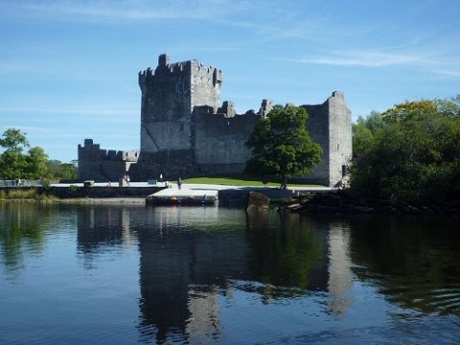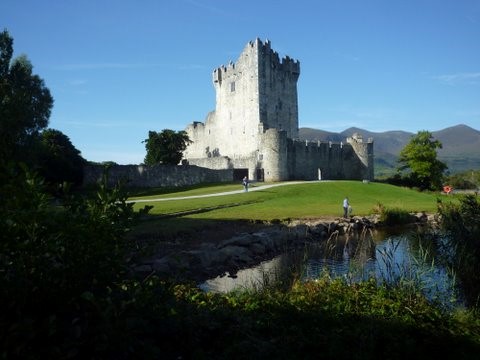
The O’Donoghues Mór of Lough Léin
The O’Donoghues were the historic residents of a castle beside Lough Léin. Cathal O’Duinnin, the O’Donoghue bard, inaugurated Tadgh the Generous there in the fourteenth century. The final fifteenth century castle, of which a quadrangular tower remains, sits on a rock close to the water. But in 1588 Ross Castle passed from the O’Donoghues of Lough Léin after their attainder for participating in the Desmond Rebellion, to the
Ross Castle from Inisfallen

MacCarthy Mór and then, under lease, to the Brownes where it remained until the Cromwellian and Williamite wars. In 1652 the confederate Catholic Munster forces under Lord Muskerry, a MacCarthy, lost the battle of Knockniclashy to the Cromwellian Ludlow. He moved on to Ross Castle to make a final stand while awaiting help from France. Ludlow in his memoirs says that he had four thousand foot and two thousand horse, while Muskerry had five thousand men in his force, with fifteen hundred inside the castle. No doubt O’Donoghues were amongst them.
However, Ross Castle was thought to be impregnable. There was a prophecy that ‘Ross Castle could not be taken until ‘a ship should swim upon the lake’. This poem adds imagery to the tale:
‘Till Birnam Wood meets Dunsinane
Macbeth before no foe shall quail,
And Ross may all assault disdain
Till on Lough Lein strange ships shall sail.’

By courtesy of Rod
Ludlow, recognizing the difficulty of attacking by land, decided to approach from the lake. According to Prendergast, he had boats built in Kinsale and transported by land, in knocked-down form, to the Killarney area, where they were assembled and launched. The sight of these boats caused total dismay to Muskerry’s men and they capitulated without further conflict. The suffering from Cromwellian retribution, following this defeat, was awful.
Ross Castle then became a garrison and an adjoining barracks was built. It was in active occupation during the wars towards the end of the seventeenth century. The barracks and castle remained unoccupied from the beginning of the nineteenth century until they were restored in the 90s, using traditional crafts and materials
Molahiffe Castle

Courtesy of Marie O’Sullivan
After the Battle of Mangerton in 1262 where the MacCarthy Mór chief, Cormac, was killed, the victorious O’Donoghue Mór sept under their new chief Thomas of the Ships stormed northwards to the borders of Geraldine power and appropriated Molahiffe castle. They held this territory until it was redistributed to a MacCarthy Mór sept (Feidlimidh, founder of MacCarthy of Cosmaigne) in 1280 after the death of Thomas in 1277.
All that remains is now on private property, no more than part of the wall of the castle.
